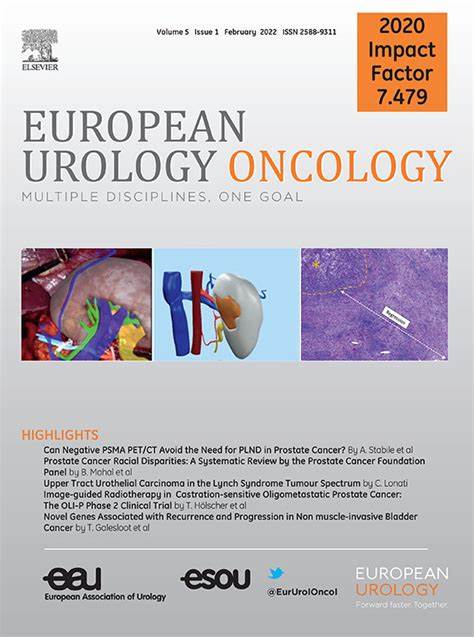Prevalence of Potential Candidates for Targeted Therapies According to Treatment-related Transcriptomic Signatures Among 140 548 Patients with Nonmetastatic Prostate Cancer
IF 9.3
1区 医学
Q1 ONCOLOGY
引用次数: 0
Abstract
Background and objective
Systemic therapies that have shown a benefit in advanced prostate cancer are being evaluated in earlier disease stages. We sought to determine the prevalence of transcriptomic changes in signatures related to treatment susceptibilities in patients with nonmetastatic prostate cancer.
Methods
Patients with nonmetastatic prostate cancer with Decipher genomic classifier and whole-transcriptome profiling data for biopsy specimens from October 2016 to February 2024 were included (n = 140 548). Predefined treatment-related signatures of androgen receptor activity (AR-A), PTEN loss, homologous recombination deficiency (HRD), RB loss, immune activity, and prostate-specific membrane antigen (PSMA; FOLH1) expression, along with Decipher scores and prostate cancer subtypes, were assessed.
Key findings and limitations
The prevalence of low AR-A scores and the basal subtype, which are associated with lower responsiveness to androgen deprivation therapy (ADT), increased with American Joint Committee on Cancer (AJCC) stage and Decipher genomic risk. The prevalence of cancers with a potential response to PI3K inhibitors, according to PTEN loss, and a response to PARP inhibitors, according to HRD status, also increased with AJCC stage and Decipher genomic risk score (all p < 0.001). The prevalence of high PSMA expression was greater in AJCC grade IIC–IIIC disease, so these patients would be potential candidates for PSMA radioligand therapies. More than 60% of patients with AJCC grade IIC–IIIC disease and very high Decipher scores (>0.85) are potential candidates for targeted therapies.
Conclusions and clinical implications
Treatment-related signature scores vary by AJCC stage and Decipher score and may be useful in guiding trials and selecting targeted therapies for nonmetastatic prostate cancer. Higher-stage prostate cancers appear to be more basal and androgen-independent, and thus may be more susceptible to intensified ADT + androgen receptor pathway inhibitors or therapies targeting PARP or PSMA.
140548例非转移性前列腺癌患者中基于治疗相关转录组特征的靶向治疗潜在候选者的患病率
背景和目的:系统性治疗在晚期前列腺癌的早期疾病阶段已经显示出益处。我们试图确定非转移性前列腺癌患者中与治疗敏感性相关的特征中转录组变化的流行程度。方法:纳入2016年10月至2024年2月具有Decipher基因组分类器和活检标本全转录组分析数据的非转移性前列腺癌患者(n = 140 548)。雄激素受体活性(AR-A)、PTEN缺失、同源重组缺陷(HRD)、RB缺失、免疫活性和前列腺特异性膜抗原(PSMA;FOLH1)表达,以及破译评分和前列腺癌亚型进行评估。主要发现和局限性:低AR-A评分和基础亚型的患病率随着美国癌症联合委员会(AJCC)分期和破译基因组风险的增加而增加,这与雄激素剥夺治疗(ADT)的低反应性相关。根据PTEN缺失,对PI3K抑制剂有潜在反应的癌症患病率,以及根据HRD状态,对PARP抑制剂有反应的癌症患病率也随着AJCC分期和破译基因组风险评分(均p 0.85)的增加而增加,这是靶向治疗的潜在候选者。结论和临床意义:治疗相关的特征评分因AJCC分期和Decipher评分而异,可能有助于指导非转移性前列腺癌的试验和选择靶向治疗。高分期前列腺癌似乎更基础和雄激素不依赖性,因此可能更容易受到强化ADT +雄激素受体途径抑制剂或针对PARP或PSMA的治疗的影响。
本文章由计算机程序翻译,如有差异,请以英文原文为准。
求助全文
约1分钟内获得全文
求助全文
来源期刊

European urology oncology
Multiple-
CiteScore
15.50
自引率
2.40%
发文量
128
审稿时长
20 days
期刊介绍:
Journal Name: European Urology Oncology
Affiliation: Official Journal of the European Association of Urology
Focus:
First official publication of the EAU fully devoted to the study of genitourinary malignancies
Aims to deliver high-quality research
Content:
Includes original articles, opinion piece editorials, and invited reviews
Covers clinical, basic, and translational research
Publication Frequency: Six times a year in electronic format
 求助内容:
求助内容: 应助结果提醒方式:
应助结果提醒方式:


